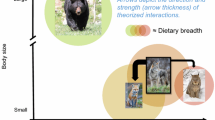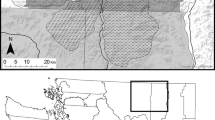Abstract
Predation can disproportionately affect endangered prey populations when generalist predators are numerically linked to more abundant primary prey. Apparent competition, the term for this phenomenon, has been increasingly implicated in the declines of endangered prey populations. We examined the potential for apparent competition to limit the recovery of Sierra Nevada bighorn sheep (Ovis canadensis sierrae), an endangered subspecies under the US Endangered Species Act. Using a combination of location, demographic, and habitat data, we assessed whether cougar (Puma concolor) predation on endangered bighorn sheep was a consequence of their winter range overlap with abundant mule deer (Odocoileus hemionus). Consistent with the apparent competition hypothesis, bighorn sheep populations with higher spatial overlap with deer exhibited higher rates of cougar predation which had additive effects on adult survival. Bighorn sheep killed by cougars were primarily located within deer winter ranges, even though those areas constituted only a portion of the bighorn sheep winter ranges. We suspect that variation in sympatry between bighorn sheep and deer populations was largely driven by differences in habitat selection among bighorn sheep herds. Indeed, bighorn sheep herds that experienced the highest rates of predation and the greatest spatial overlap with deer also exhibited the strongest selection for low elevation habitat. Although predator-mediated apparent competition may limit some populations of bighorn sheep, it is not the primary factor limiting all populations, suggesting that the dynamics of different herds are highly idiosyncratic. Management plans for endangered species should consider the spatial distributions of key competitors and predators to reduce the potential for apparent competition to hijack conservation success.





Similar content being viewed by others
References
Beyer HL (2004) Hawth’s Analysis Tools for ArcGIS. Available at http://www.spatialecology.com/htools
Bleich VC, Bowyer TR, Wehausen JD (1997) Sexual segregation in mountain sheep: resources or predation? Wildl Monogr 134:1–50
Bleich VC, Johnson HE, Holl SA, Konde L, Torres SG, Krausman PR (2008) Fire history in a chaparral ecosystem: implications for conservation of a native ungulate. Rangeland Ecol Manag 61:571–579
Bourbeau-Lemieux A, Festa-Bianchet M, Gaillard J-M, Pelletier F (2011) Predator-driven component Allee effects in a wild ungulate. Ecol Lett 14:358–363
Boyce MS, Vernier PR, Nielsen SE, Schmiegelow FKA (2002) Evaluating resource selection functions. Ecol Model 157:281–300
Bryant AA, Page RE (2005) Timing and causes of mortality in the endangered Vancouver Island marmot (Marmota vancouverensis). Can J Zool 83:674–682
Burnham KP, Anderson DR (2002) Model selection and multimodel inference: a practical information-theoretic approach, 3rd edn. Springer, New York
Burnham KP, White GC, Anderson DR (1984) Estimating the effect of hunting on annual survival rates of adult mallards. J Wildl Manag 48:350–361
Caswell H (2001) Matrix population models: construction, analysis and interpretation, 2nd edn. Sinauer, Sunderland
Chaneton EJ, Bonsall MB (2000) Enemy-mediated apparent competition: empirical patterns and the evidence. Oikos 88:380–394
Courchamp F, Woodroffe R, Roemer G (2003) Removing protected populations to save endangered species. Science 302:1532
Cushman SA, Wallin DO (2002) Separating the effects of environmental, spatial and disturbance factors on forest community structure in the Russian Far East. For Ecol Manag 168:201–215
DeCesare N, Pletscher D (2006) Movements, connectivity, and resource selection of Rocky Mountain bighorn sheep. J Mammal 87:531–538
DeCesare N, Hebblewhite M, Robinson H, Musiani M (2010) Endangered, apparently: the role of apparent competition in endangered species conservation. Anim Conserv 13:353–362
Festa-Bianchet M, Coulson T, Gaillard J-M, Hogg JT, Pelletier F (2006) Stochastic predation events and population persistence in bighorn sheep. Proc R Soc Lond B 273:1537–1543
Gaillard J-M, Festa-Bianchet M, Yoccoz NG, Loison A, Toïgo C (2000) Temporal variation in fitness components and population dynamics of large herbivores. Annu Rev Ecol Syst 31:367–393
Gibson L (2006) The role of lethal control in managing the effects of apparent competition on endangered prey species. Wildl Soc Bull 34:1220–1224
Gillies CS, Hebblewhite M, Nielsen SE, Krawchuk MA, Aldridge CL, Frair JL, Saher DJ, Stevens CE, Jerde CL (2006) Application of random effects to the study of resource selection by animals. J Anim Ecol 75:887–898
Greene L (2010) Short-term effects of wildfire on Sierra Nevada bighorn sheep habitat ecology. MS thesis, University of Montana, Missoula
Griffin KA, Hebblewhite M, Robinson HS, Zager P, Barber-Meyer SM et al (2011) Neonatal mortality of elk driven by climate, predator phenology and predator community composition. J Anim Ecol 80:1246–1257
Halofsky JS, Ripple WJ (2008) Fine-scale predation risk on elk after wolf reintroduction in Yellowstone National Park, USA. Oecologia 155:869–877
Hebblewhite M, Merrill EH (2007) Multiscale wolf predation risk for elk: does migration reduce risk? Oecologia 152:377–387
Hebblewhite M, Merrill EH (2009) Trade-offs between risk and forage differ between migrant strategies in a migratory ungulate. Ecology 90:3445–3454
Heisey DM, Patterson BR (2006) A review of methods to estimate cause-specific mortality in presence of competing risks. J Wildl Manag 70:1544–1555
Holling CS (1959) The components of predation as revealed by a study of small-mammal predation of the European pine sawfly. Can Entomol 91:293–320
Holt RD (1977) Predation, apparent competition and the structure of prey communities. Theor Popul Biol 12:197–229
Holt RD, Lawton JH (1993) Apparent competition and enemy-free space in insect host-parasitoid communities. Am Nat 142:623–645
Holt RD, Lawton JH (1994) The ecological consequences of shared natural enemies. Annu Rev Ecol Syst 25:495–520
Horne JS, Garton EO (2006) Likelihood cross-validation versus least squares cross-validation for choosing the smoothing parameter in kernel home-range analysis. J Wildl Manag 70:641–648
Horne JS, Garton EO (2007) Animal Space Use 1.3. http://www.cnr.uidaho.edu/population_ecology/animal_space_use.htm
Hosmer DW, Lemeshow S (2000) Applied logistic regression, 2nd edn. Wiley, New York
James ARC, Boutin S, Hebert DM, Rippin AB (2004) Spatial separation of caribou from moose and its relation to predation by wolves. J Wildl Manag 68:799–809
Johnson DH (1980) The comparison of usage and availability measurements for evaluating resource preference. Ecology 61:65–71
Johnson CJ, Nielsen SE, Merrill EH, McDonald TL, Boyce MS (2006) Resource selection functions based on use-availability data: theoretical motivations and evaluation methods. J Wildl Manag 70:347–357
Johnson HE, Mills LS, Stephenson TS, Wehausen JD (2010a) Population-specific vital rate contributions influence management of an endangered ungulate. Ecol Appl 20:1753–1765
Johnson HE, Mills LS, Wehausen JD, Stephenson TS (2010b) Combining minimum count, telemetry, and mark-resight data to infer population dynamics in an endangered species. J Appl Ecol 47:1083–1093
Kie JG, Bowyer RT, Boroski BB, Nicholson MC, Loft ER (2002) Landscape heterogeneity at differing scales: effects on spatial distribution of mule deer. Ecology 83:530–544
Kittle AM, Fryxell JM, Desy GE, Hamr J (2008) The scale-dependent impact of wolf predation risk on resource selection by three sympatric ungulates. Oecologia 157:163–175
Knopff KH, Knopff AA, Warren MB, Boyce MS (2009) Evaluating global positioning system telemetry techniques for estimating cougar predation parameters. J Wildl Manag 73:586–597
Lessard RB, Martell SJD, Walters CJ, Essington TE, Kitchell JF (2005) Should ecosystem management involve active control of species abundances? Ecol Soc 10:1–23
Lima SL, Dill LM (1990) Behavioral decisions made under the risk of predation: a review and prospectus. Can J Zool 68:619–640
Manly BFJ, McDonald LL, Thomas DL, McDonald TL, Erickson WP (2002) Resource selection by animals; statistical design and analysis for field studies, 2nd edn. Kluwer, Boston
McLellan BN, Serrouya R, Wittmer HU, Boutin S (2010) Predator-mediated Allee effects in multi-prey systems. Ecology 91:286–292
Menard S (1995) Applied logistic regression analysis. Sage, Thousand Oaks
Messier F (1994) Ungulate population models with predation: a case study with the North American moose. Ecology 75:478–488
Mills LS (2007) Conservation of wildlife populations: demography, genetics and management. Blackwell, Malden
Murray DL, Smith DW, Bangs EE, Mack C, Oakleaf JK et al (2010) Death from anthropogenic causes is partially compensatory in recovering wolf populations. Biol Conserv 143:2514–2524
Mysterud A, Ims RA (1998) Functional responses in habitat use: availability influences relative use in trade-off situations. Ecology 79:1435–1441
Owen-Smith N, Mason DR (2005) Comparative changes in adult vs. juvenile survival affecting population trends of African ungulates. J Anim Ecol 74:762–773
Parker KL, Barboza PS, Gillingham MP (2009) Nutrition integrates environmental responses of ungulates. Funct Ecol 23:57–69
Pierce BM, Bleich VC, Chetkiewicz CLB, Wehausen JD (1998) Timing of feeding bouts of mountain lions. J Mammal 79:222–226
Pierce BM, Bleich VC, Wehausen JD, Bowyer RT (1999) Migratory patterns of mountain lions: implications for social regulation and conservation. J Mammal 80:986–992
Pierce BM, Bleich VC, Bowyer RT (2000) Social organization of mountain lions: does a land-tenure system regulate population size? Ecology 81:1533–1543
Pollock KH, Winterstein SR, Bunck CM (1989) Survival analysis in telemetry studies: the staggered entry design. J Wildl Manag 53:7–15
Roemer GW, Donlan CJ, Courchamp F (2002) Golden eagles, feral pigs, and insular carnivores: how exotic species turn native predators into prey. Proc Nat Acad Sci USA 99:791–796
Sappington JM, Longshore KM, Thompson DB (2007) Quantifying landscape ruggedness for animal habitat analysis: a case study using bighorn sheep in the Mojave desert. J Wildl Manag 71:1419–1426
Schaub M, Lebreton J-D (2004) Testing the additive versus the compensatory hypothesis of mortality from ring recovery data using a random effects model. Anim Biodivers Conserv 27:73–85
Sinclair ARE, Pech RP, Dickman CR, Hik D, Mahon R, Newsome AE (1998) Predicting effects of predation on conservation of endangered prey. Conserv Biol 12:564–575
Smith TS, Flinders JT, Winn DS (1991) A habitat evaluation procedure for Rocky Mountain bighorn sheep in the intermountain west. Great Basin Nat 51:205–225
Torres S, Mansfield TM, Foley JE, Lupo T, Brinkhaus A (1996) Mountain lion and human activity in California: testing speculations. Wildl Soc Bull 24:451–460
US Fish and Wildlife Service (2007) Recovery Plan for the Sierra Nevada bighorn sheep. USFWS, Sacramento
Valeix M, Loveridge AJ, Chamaillé-Jammes S, Davidson Z, Murindagomo F, Fritz H, Macdonald DW (2009) Behavioral adjustments of African herbivores to predation risk by lions: spatiotemporal variations influence habitat use. Ecology 90:23–30
Walker ABD, Parker KL, Gillingham MP, Gustine DD, Lay RJ (2007) Habitat selection by female Stone’s sheep in relation to vegetation, topography, and risk of predation. Ecoscience 14:55–70
Wehausen JD (1996) Effects of mountain lion predation on bighorn sheep in the Sierra Nevada and Granite Mountains of California. Wildl Soc Bull 24:471–479
Williams BK, Nichols JD, Conroy MJ (2002) Analysis and management of animal populations. Academic, San Franciso
Wittmer HU, McLellan BN, Seip DR, Young JA, Kinley TA, Watts GS, Hamilton D (2005) Population dynamics of the endangered mountain ecotype of woodland caribou (Rangifer tarandus caribou) in British Columbia, Canada. Can J Zool 83:407–418
Worton BJ (1989) Kernel methods for estimating the utilization distribution in home-range studies. Ecology 70:164–168
Worton BJ (1995) Using Monte Carlo simulation to evaluate kernel-based home range estimators. J Wildl Manag 59:794–880
Acknowledgments
We are grateful to all the people who have collected data on bighorn sheep, mule deer, and cougars in the Eastern Sierra including C. Baker, L. Bowermaster, J. Davis, V. Davis, K. Ellis, J. Erlenbach, A. Feinberg, J. Fusaro, L. Greene, D. Jensen, M. Kiner, K. Knox, K. Monteith, R. Noles, J. Ostergard, N. Partridge, P. Partridge, C. Schroeder, D. Spitz, A. Stephenson, J. Wehausen, and others. We thank Landells Aviation and Quicksilver Air for safely conducting bighorn sheep and deer helicopter captures. We are grateful to L.S. Mills, M. Mitchell, D. Pletscher, G. Luikart, and H. Robinson for providing constructive discussion and comments on this manuscript. We also thank J.-M. Gaillard and 2 anonymous reviewers for their suggested revisions. CDFG and the Canon National Parks Scholars Program provided funding for this work.
Author information
Authors and Affiliations
Corresponding author
Additional information
Communicated by Jean-Michel Gaillard.
Rights and permissions
About this article
Cite this article
Johnson, H.E., Hebblewhite, M., Stephenson, T.R. et al. Evaluating apparent competition in limiting the recovery of an endangered ungulate. Oecologia 171, 295–307 (2013). https://doi.org/10.1007/s00442-012-2397-6
Received:
Accepted:
Published:
Issue Date:
DOI: https://doi.org/10.1007/s00442-012-2397-6




